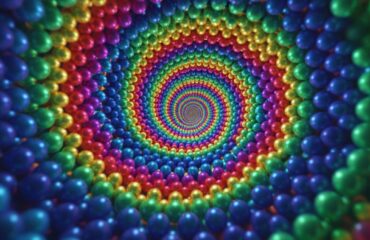
How is time represented in our minds? Image: Marco Verch
Life is a continuous experience, a one-way trip in time.
Humans give structure to this experience by marking the passing of time together – for example, with calendars and watches, by the changing of seasons and other patterns in nature, and observing cycles in the motion of planets and positions of stars. These and other means allow us to pinpoint events in time and arrange them chronologically, giving coherence and meaning to the sequences of cause and effect in our lives.
Logging the passing of time is so crucial that, as recent scientific findings reveal, our brains have neurons referred to as “time cells” that have been shown to play a fundamental role in our ability to remember past events.
Time cells encode time into our memories. More specifically, they form our episodic memories which involve remembering the “what”, “where”, and “when” of past experiences. Episodic memory differs from semantic memory, which registers, for example, names, dates, and meanings.
“Neurons are the basic unit of the nervous system. A neuron is a specialized cell with an architectural conformation that is capable of rapid voltage changes in its membrane, which allows it to communicate with other cells.” Cano et al. (2017).
The brain’s time cells seem to mark the boundary between distinct events as we experience them, for example when someone knocks on the door and in the next event enters the room.
This explains why time cells are also known as “boundary cells.” Time cells are found in the hippocampus, a region composed of two curved structures on either side of the brain that is crucial for making new memories. These neurons allow us to organize the memories of distinct moments in a particular experience of time.
Scientists have been studying this aspect of our memory for decades and had previously found some hippocampal neurons in mice that are responsible for indexing memories sequentially. While many species are known to be able to store the “who”, “what”, and “where” of episodes in their memories, only the brains of mice had been shown in the lab to capture the “when” as well. Given the difficulties in assessing this deep brain region, robust evidence that a similar pattern occurs in the human brain only came in a 2021 study led by Dr. Leila Reddy, a neurobiologist and researcher at the Brain and Cognition Research Center, in France.

The brain’s hippocampus, crucial for new memory formation. Image Source
Epilepsy patients often have electrodes implanted into their hippocampus for treatment, because that is the region of the brain where seizures start.
By monitoring the neural activity in the hippocampus of such patients, Dr. Reddy’s team was able to identify human time cells for the first time. They asked participants to memorize a sequence of pictures, then evaluated what happened in their brains as the sequence was randomly replayed and paused and participants were asked to remember which image would come next. The researchers found that hippocampal neurons fired when images were displayed and also during the pauses or gaps between pictures.
The pattern found by the team suggested that while around 70% of the active neurons likely serve to store information on “what” was shown, the other 30% seem to organize the images sequentially and operate as the “time cells.”
Now, a new study led by Dr. Jie Zheng, a Harvard post-doctoral researcher at the Boston Children’s Hospital, has revealed more details about these mysterious cells.
Dr. Zheng’s team recorded the activity of single neurons in the human medial temporal lobe (MTL) during the formation and retrieval of memories with complex narratives and found evidence of bursts of activity in individual neurons that mark the boundary between different events. “It has long been appreciated in psychology that memory is not continuous, that it’s formed in chunks. But this has never been observed at the single neuron level,” says Ueli Rutishauser, from the Cedars-Sinai Medical Center in Los Angeles, who co-authored the study.
“The medial temporal lobe includes a system of anatomically related structures that are essential for declarative memory (conscious memory for facts and events). The system consists of the hippocampal region (CA fields, dentate gyrus, and subicular complex) and the adjacent perirhinal, entorhinal, and parahippocampal cortices.” Squire et al. (2004).
It seems that time cells tell the brain when it is time to begin forming a new memory, “like starting a new folder,” says Rutishauser: “They don’t say anything about the memory content, they just say there is a boundary.” Test subjects were better at remembering images that appeared immediately after a boundary than those that happened a few seconds later.
This finding suggests time cells are “a mechanism by which the hippocampus is signaling what scenes to put together and what scenes not to put together,” says Rodrigo Quian Quiroga, from the University of Leicester, UK. In other words, time cells help sequential memory recall, structuring what some call “mental time travel” – during memory retrieval when we send some part of our mind back along our autobiographical timeline to a specific moment in the past.
It is worth noting that some researchers oppose the idea of mental time travel.
In a 2021 paper, Jeremy Manning, assistant professor of Psychological and Brain Sciences at Dartmouth University, proposes an alternative view. Inspired by recent evidence on how neurons operate in parallel to represent multiple events at different timescales, Manning argues that instead of mentally revisiting any specific moment of our past, “we retrieve information from our past by mentally casting ourselves back simultaneously to many time points from our past, much like a quantum wave function spreading its probability mass over many possible states.”
“In quantum mechanics, wave function collapse occurs when a wave function—initially in a superposition of several eigenstates—reduces to a single eigenstate [a condition with potential for change in scale only] due to interaction with the external world. This interaction is called an observation, and is the essence of a measurement in quantum mechanics, which connects the wave function with classical observables such as position and momentum”. Wikipedia
Visiting a specific time in memory would require what some refer to as “chronesthesia”, a form of time-related consciousness that allows individuals to think of the “present” in which they live, and “mentally travel” thanks to connections between past and future.
“Analogous to how measuring the physical location of a particle collapses its quantum wave function at the moment of measurement, engaging in chronesthesia can collapse our quantum memory wave function such that our thoughts temporarily converge on the moment we are revisiting. This wave function expands again when our mental state changes in the next moment”, says Manning.
This logic is similar to the operation of memory in quantum computing: you can hold multiple pieces of information in parallel, as long as they are not observed, points out Christopher Monroe, a researcher in the Department of Physics at the University of Maryland, Joint Quantum Institute, and Center for Quantum Information and Computer Science.
There is still a lot we do not know about the complex workings of human memory.
For one thing, the lead author of the 2021 study, Leila Reddy, says it seems possible that time cells could record other types of information too, as they leave “real estate available for other things to be encoded.” Furthermore, it is possible that “the population of time cells in the hippocampus is representing several different and overlapping timescales,” says Matthew Self, Reddy’s co-author. He adds, “It appears that hippocampal cells are multidimensional and can encode different aspects of our experiences in their firing patterns.” Their research agenda currently seeks to investigate how time information combines with contextual information to provide temporal structure to our memories.
Some scientists believe these findings could, one day, help develop “memory prosthetics,” allowing a computer to insert or delete memories with electrodes placed in the brain – which would raise many ethical issues.
But this technology could also lead to strategies for memory restoration or enhancement. Remembering events but having trouble placing them in the right order can often affect the quality of life of individuals with neurodegenerative conditions such as Alzheimer’s disease. Pioneering studies and continuing research on the operation of time cells shed more light on human memory functions, and bring us closer to understanding its defects and potential.



